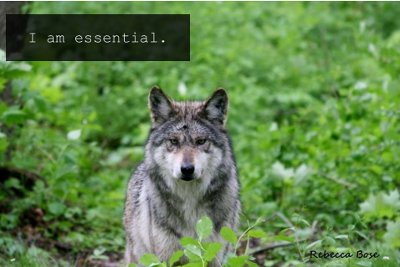In the News: Deaths of 2 Mexican gray wolves investigated

Wildlife managers are investigating the deaths of two Mexican gray wolves found in May in New Mexico.
The interagency team that oversees recovery of the endangered species in New Mexico and Arizona documented the deaths of a female that was not with a pack and a male that was part of the Frieborn Pack. Officials in a monthly report made public last week did not release any other details about the circumstances.
In all, officials have reported a dozen wolf mortalities among the wild population over the first five months of the year.
Environmentalists have raised concerns about the leader of another wolf pack being killed for preying on livestock. The Saffel pack roams the northeastern portion of the Apache-Sitgreaves National Forest near the Arizona-New Mexico border.
The Center for Biological Diversity said the pack’s alpha male was the 21st wolf to be shot by the government since reintroduction of the species began in the Southwest U.S. two decades ago. The organization also said it’s the fifth to be shot by federal employees this year.
The Mexican gray wolf was once common throughout portions of the Southwest and Mexico. By the 1970s, it had been hunted, trapped and poisoned to near-extinction.
In 1998, state and federal wildlife managers began reintroducing the Mexican wolves – a subspecies of the gray wolf – with the experimental release of 11 captive-bred wolves. There are now at least 163 wolves roaming the two states, according to the latest survey.
The U.S. Fish and Wildlife Service, which leads the interagency recovery team, is under a court order to rewrite the rule governing management of the wolves.
Thousands of comments were submitted before the June 15 deadline. The federal agency is expected to issue a draft rule and an environmental impact statement later this year, triggering another public comment period.
This article was published in the Albuquerque Journal.
~~~~~~~~~~~~~~~~~~
Please take a stand for Mexican wolf recovery
with a letter to the editor!
The letters to the editor page is one of the most widely read, influential parts of the newspaper. One letter from you can reach thousands of people and will also likely be read by decision-makers. Tips and talking points for writing your letter are below, but please write in your own words, from your own experience.
TALKING POINTS:
- Far too many endangered Mexican gray wolves are illegally killed every year. Already this year (from January 1 to May 31) the IFT has documented 12 wolf mortalities. Eleven of these deaths are under investigation.
- Mexican gray wolves are the most endangered gray wolf in North America and is protected under the Endangered Species Act. Under the Endangered Species Act it is illegal to “harass, harm, pursue, hunt, shoot, wound, kill, trap, capture, or collect; or to attempt any of these”.
- The U.S. Fish and Wildlife Service must get serious about curbing illegal killings of endangered Mexican gray wolves by increasing public acceptance of wolves and increasing penalties to dissuade wolf killers. When wolves are illegally killed, there must be repercussions or people will assume they’re unlikely to be caught or punished for the crime.
- The death of one wolf disrupts pack structure and leaves the whole pack vulnerable and leads to more problems. Wolf-killers set recovery back and cause the recovery program to cost taxpayers more every time a valuable endangered species is killed.
- Mexican gray wolves are critically endangered and every illegal killing does significant damage to the recovery of the species.
LETTER WRITING TIPS
Make sure you:
- Thank the paper for this article and make sure to reference it in your LTE.
- Submit your letter as soon as possible. The chance of your letter being published declines after a day or two since the article was published.
- Keep your message positive, but firm in your support for lobo recovery.
- Keep your letter brief, no more than 200 words. Letters will be edited for space and clarity.
- Include something about who you are and why you care: E.g. “I am a mother, outdoors person, teacher, business owner, scientific, religious, etc.” Don’t be afraid to be personal and creative.
- Provide your name, address, phone number and address. The paper won’t publish these, but they want to know you are who you say you are.
- Submit your letter to the editor of the Albuquerque Journal here.
Thank you for speaking for Mexican wolves.



